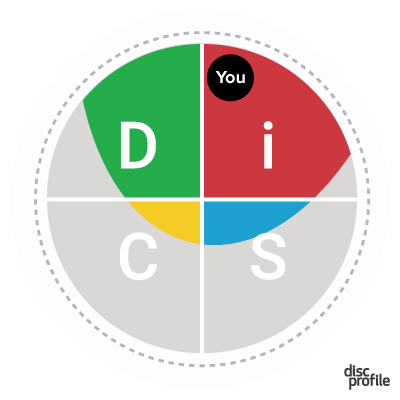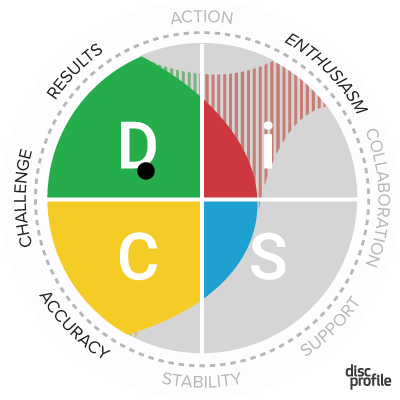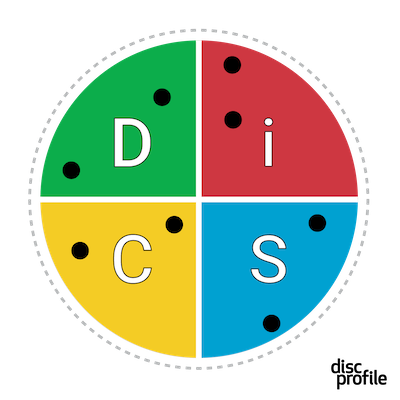DiSC®
dot and priorities explained
If you’re used to just talking about styles and preferences, Everything DiSC’s use of dots and priorities might be a little confusing. Everything DiSC® is about more than just a single letter or two denoting your personality style. It’s so much richer.
Your DiSC dot
Each person who takes an Everything DiSC assessment has their dot plotted on the Everything DiSC map. The example below shows a person who tends toward the i region, but also somewhat toward the D region. This represents an iD style. This person, therefore, is probably particularly outspoken, active, bold, and persuasive, as these qualities generally describe people who share both the i and D styles.

DiSC style
Everything DiSC defines a style as “a set of typical response patterns that are expected from a person. However, that doesn’t mean that a person can only exhibit that pattern. For instance, an individual tested with a resulting dot located in the D quadrant will demonstrate more dominant behaviors and preferences than a person with another style, but will also, from time to time, show behaviors and preferences that are associated with the other three quadrants.”
Read more about four basic DiSC styles:
- Dominance (D) DiSC style
- Influence (i) DiSC style
- Steadiness (S) DiSC style
- Conscientiousness (C) DiSC style
Style inclination
If you look at the DiSC map for several people you’ll notice that not everyone’s dot is placed at the same distance from the center. That distance is also meaningful. People whose dots fall toward the edge of the circle are said to be much more inclined toward their DiSC styles. The style characteristics of someone with their dot near the outer edge will be much more pronounced than for someone whose dot is closer to the center of the circle.
As explained in the Everything DiSC Manual:
Your shading
The shading around the dot provides a rough approximation of the person’s comfort zone. In the example below, this person with a D style will find behaviors such as focusing on results, welcoming a challenge, and being accurate will come easily. Conversely, behaviors associated with the styles with little shading (being collaborative, offering support, seeking stability) will require more conscious effort. The shading reinforces the message that we are all a blend of all four styles.
Your DiSC priorities
The shading also includes the three priorities closest to a person’s dot. In our example from Everything DiSC Workplace, these are accuracy, challenge, and results. The priorities are an additional measurement unique to Everything DiSC. As the Everything DiSC Manual explains: “the priority scales measure much more narrow constructs. For example, the i DiSC scale measures a sociable, lively disposition. The priority scale of Enthusiasm measures only liveliness.” This provides a more nuanced feedback in the resulting profile.
Not all people with the C style, for example, are the same. Some people will show more than three priorities. Their DiSC map will include extra shading if their score on the priority is over a pre-set threshold. The example below shows an additional priority of enthusiasm for this D-style individual.

The Everything DiSC Manual explains:
People with a fourth or fifth priority will see those reflected in their Everything DiSC Workplace profile section on motivators and stressors (pages 5-6). The priorities assessed differ among the Everything DiSC assessments. For example, the priority for the S is Support in the Workplace and Management profiles, Sincerity in the Sales profile, and Inclusive in the Work of Leaders profile. See sample reports of each Everything DiSC profile.


